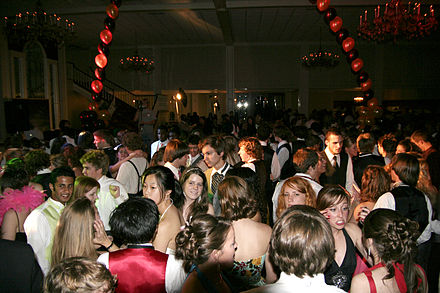Prom
A promenade dance,[1][2] commonly called a prom, is a dance party for high school students. It may be offered in semi-formal black tie or informal suit for boys, and evening gowns for girls. This event is typically held near the end of the school year. There may be individual junior (11th grade) and senior (12th grade) proms or they may be combined.
At a prom, a "prom king" and a "prom queen" may be revealed. These are honorary titles awarded to students elected in a school-wide vote prior to the prom.[3] Other students may be honored with inclusion in a prom court. The selection method for a prom court is similar to that of homecoming queen/princess, king/prince, and court. Inclusion in a prom court may be a reflection of popularity of those students elected and their level of participation in school activities, such as clubs or sports.[4][5]The prom queen and prom king may be given crowns to wear. Members of the prom court may be given sashes to wear and photographed together.[6]
Similar events, which may be locally inspired by debutante balls, take place in many other parts of the world. In Canada, the terms "formal" and "Grad" are often used, while in Australia and New Zealand, the terms school formal and ball are most commonly used for occasions equivalent to the American prom, and the event is usually held for students in Year 12, although the bestowing of the regal titles does not occur. Many schools hold a formal graduation ball for finishing students at the end of the year in place of or as well as a formal. In Ireland, a debutante ball or debs may also be held. In Poland, high schools organize a "studniówka". The term "prom" is becoming more common in the United Kingdom and Canada because of the influence of American films and television shows, such as Grease.In South Africa this event is widely known as a matric dance as students in their 12th year of school are called matric students.
Variation exists between different dialects with regard to whether prom is used with the definite article or not—e.g., whether one says "go to the prom" or "go to prom".[7]
In the early days of high school proms, the nighttime dance served a function similar to a debutante ball. Early proms were times of firsts: the first adult social event for teenagers; the first time taking the family car out after dark; the first real dress-up affair; and so forth. Proms also served as a heavily documented occasion, similar to a milestone event such as first communion or a wedding, in which the participants were taking an important step into a new stage in their lives. In earlier days, the prom may have also served as an announcement of engagement for the 'best couple' after the prom court had been crowned and recognized.[8]
While high school yearbooks did not start covering proms and including prom pictures until the 1930s and 1940s, historians, including Meghan Bretz, believe proms may have existed at colleges as early as the late 19th century. The journal of a male student at Amherst College in 1894 recounts an invitation and trip to an early prom at neighboring Smith College for women. The word prom at that time may just have been a fancy description for an ordinary junior or senior class dance, but prom soon took on larger-than-life meaning for high school students.[9]




.jpg/440px-Portrait_of_African_American_couple_at_Lincoln_High_School_senior_prom_(6846385789).jpg)
